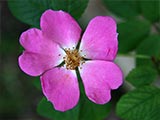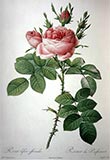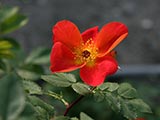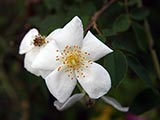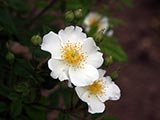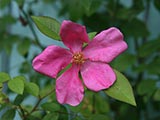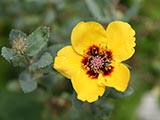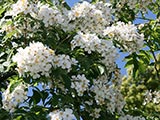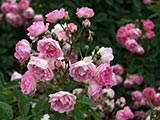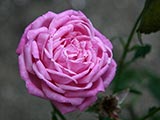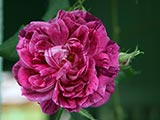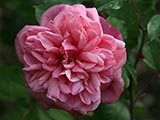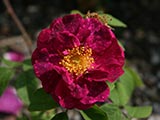Biodiversity, history and patrimonial interest of heritage roses
Translated by Nimet Monasterly-Gilbert and Alan Gilbert
|
Close to 40,000 varieties of roses are grown on almost every continent both in gardens and urban settings. In nature, the genus Rosa accounts or close to 200 wild species which are only found in the northern hemisphere. Wild roses have simple flowers with almost always five petals (only four in some Himalayan taxa). Modern roses all derive from a few species as well as a handful of very old hybrids grown since antiquity for medical use, in cosmetics or for dietary purposes.
The following is a brief history of cultivated roses, in no particular chronological context. |
|
The origin, roses grown for their scent…
|
The very old heritage roses in Europe and occidental Asia were mainly grown for their scent and the production of attar, a knowledge most likely acquired from Persia (present day Iran). Principally it was varieties such as the Damask rose (the clone of one variety dates back 2,000 years), the Alba rose (which derives from Rosa canina) and Centifolia roses (from which most Moss roses descend). Rosa centifolia is still grown in Grasse today, thus continuing a long tradition.
All these roses descend from Rosa Gallica which had been used by apothecaries notably in Provins as early as the 13th century both for its medicinal attributes as well as in cosmetics. It is primarily their petals which are responsible for their varying notes in their perfume. And for this reason, forms of double-flowered roses (between five and a few dozen petals) were systematically selected and put into culture. |
|
… but also for esthetical reasons
This latter trait is also appreciated for esthetic reasons. There are depictions of gardens containing double-flowered roses on the frescos in ancient Pompei. Closer to our time, double-flowered roses that may be Gallicas or Albas figure on wood panel paintings such as La Vierge au Buisson de roses (The Virgin with the roses) by Martin Schongauer (1473). The varieties bred for garden use progressively diversified with the appearance of much darker shades of crimson and violet in the Gallicas.
Varieties from central Asia both added to the range of their perfume as well as to their color (Rosa damascena). Whereas Rosa foetida which is at the origin of the ‘Pernetiana’ group of roses, transmitted to them shades of yellow, salmon and orange.
Distinct ploidy levels
|
The majority of roses describes thus far are tetraploid (28 chromosones) with the exception of Albas which are hexaploid (42 chromosones) or occasionally triploid (21). But roses that are diploid (14) also played an important role. One of the oldest grown in Europe during the Middle Ages is the Musk Rose (Rosa moschata) whose origin is from central Asia. The rose produces enormous panicles of simple white blooms. Its musky and volatile scent stems from its stamens and not the petals.
Rosa moschata forms part of the constitution of Damask Roses, into the horticultural group of ‘Noisettes’ but also into the more recent ‘Hybrid Musks’ grown for garden use as well as landscape roses. |
|
The diploid groups are important as well
Two principal groups of diploid roses contributed to the makeup of different horticultural types of heritage roses. Those belonging to the Synstylae whose female styles are fused into a column, these include R. moschata, R. sempervirens, R. arvensis, R. multiflora, R. luciae (formely known as R. wichurana), and R. setigera. They contributed to the earliest climbers and ramblers whose impressive cascade of blooms occurred once a year (non-reblooming).
The other group is represented by the Indicae which includes R. chinensis and the two sub-species of ‘Tea’ roses, R. odorata odorata and R. ordorata gigantea. They are strong arching schrubs or ramblers, which bloom only once a year and that were grown in China for millenia. Within this group, recessive mutations that occurred around ten centuries ago, changed the course of the history of rose-growing. These mutations lead to smaller bush form growth as well as the ability to continue blooming throughout the growing season. These continuously flowering plants were deeply appreciated. Other dominant but independent mutations from those already mentioned gave rise to dwarf roses, the ‘Lawrencianas’ which were highly popular in the 19th and early 20th centuries as they could be grown in pots.
The influence of various species
The diversity, is of course, far more complex, and we ought not to forget other horticultural groups whose contributions are very relevant such as R. rugosa, R. banksiae, R. pimpinellifolia, R. bracteata, R. laevigata, R. blanda, R. moyesii, R. roxburghii, R. persica which contributed to the ‘Boursaults’, the ‘Burnets’…
In France, we consider a heritage rose as any plant that has been grown for at least 90 years. While it is evident that more recent but highly innovative creations, such as the primary hybrids of R. persica are also considered to be of historic value and as such deserve the same attention and protection.
The Golden Age of the rose
Towards the end of the 18th century but mainly at the beginning of the 19th, the infatuation for roses exploded throughout France and Europe and spread to other continents. Enlightened amateurs created new roses raised from seed. The recessive mutations enabling re-blooming were progressively passed into the other horticultural forms to create new ones. Therefore, re-blooming hybrids of R. multiflora and R. luciae are nothing else than ‘Polyanthas’ and small ground covers respectively. Via the ‘Portlands’, the Gallicas, the Damasks lead to the ‘Bourbons’, to the ‘Hybrid Perpetuals’ as well as to the ’Hybrid Teas’.
The modern roses do not overshadow heritage roses
|
Despite the impressive range of colours and shapes of modern roses, the sheer appeal of Heritage roses remains. What could be more elegant than the angular divaricated shape of an old variety of old chinensis or the changing colors of a ‘Tea’! What scent could rival in complexity that of the Damasks or the ‘Albas’ roses such as ‘Maiden’s Blush’ or ‘Königin von Dänemark’? How could one not be moved at the sight of springtime showers of blooms of the climbing forms of ‘Pompom de Paris’, ‘Mademoiselle Cécile Brunner’ or the ‘Tea Noisettes’?
|
|
A Heritage rose for any location
|
There exists a Heritage rose for any location, from the smallest of gardens to the largest parks, from miniatures that can be grown in pots to large ramblers that can climb through the limbs of trees reaching 15 meters high. Among those that bloom but once yearly, on can anticipate a succession of blooms from the month of April to that of July depending on the variety chosen. There exist sorts whose continual blooming can flower weather permitting, from April through December. These are to be found mainly among the ‘Chinas’ that never stop blooming in our oversea departments such as the island of Reunion.
|
|
Care free Heritage roses
Certain varieties are less resistant to cold climates, such as the oldest varieties of the ‘Banskians’ or the ‘Tea Noisettes’ and show their full potential on the Riviera or in the Gers. While others like the Gallicas, the Rugosas and the Burnet roses can easily withstand temperatures dipping below -30°C in mountain villages.
Heritage roses adapt to most soils. Many among them, especially the primary hybrids, the wild species and their close derivatives, thrive even in the poorest of soil.
One can sometimes find specimens of old roses in abandoned cemeteries that have survived despite being neglected for decades. Many old varieties are resistant to the most common fungal diseases that plague roses making them ideal for those wishing to have trouble-free roses that require no special care. Added to which, most old varieties require little if any pruning, simply the removal of dead canes and dead heading.
Resources both for varietal innovation and for research
The biodiversity of Heritage roses is enormous and is of interest to this day to rose breeders. Their genetic pool is important as it holds the keys to traits still underestimated for their potential varietal selection. They are a reservoir of plant resource for scientists to explore the active components, volatiles and pigments. More and more fascinating studies are being undertaken to trace the origin of their pedigrees and genealogy of Heritage roses. It is therefore important to understand and preserve these varieties that have withstood the test of time.
About the author…Pascal HEITZLER, Vice-President of Roses Anciennes in France, Geneticist, Director of Research at the CNRS, founded an experimental rose garden with more than 1,000 accessions and original pedigrees. He is conducting research on the genetic, the metabolism and the development of roses at the Institute of Molecular Plant Biology (IBMP) in Strasbourg. |

|
